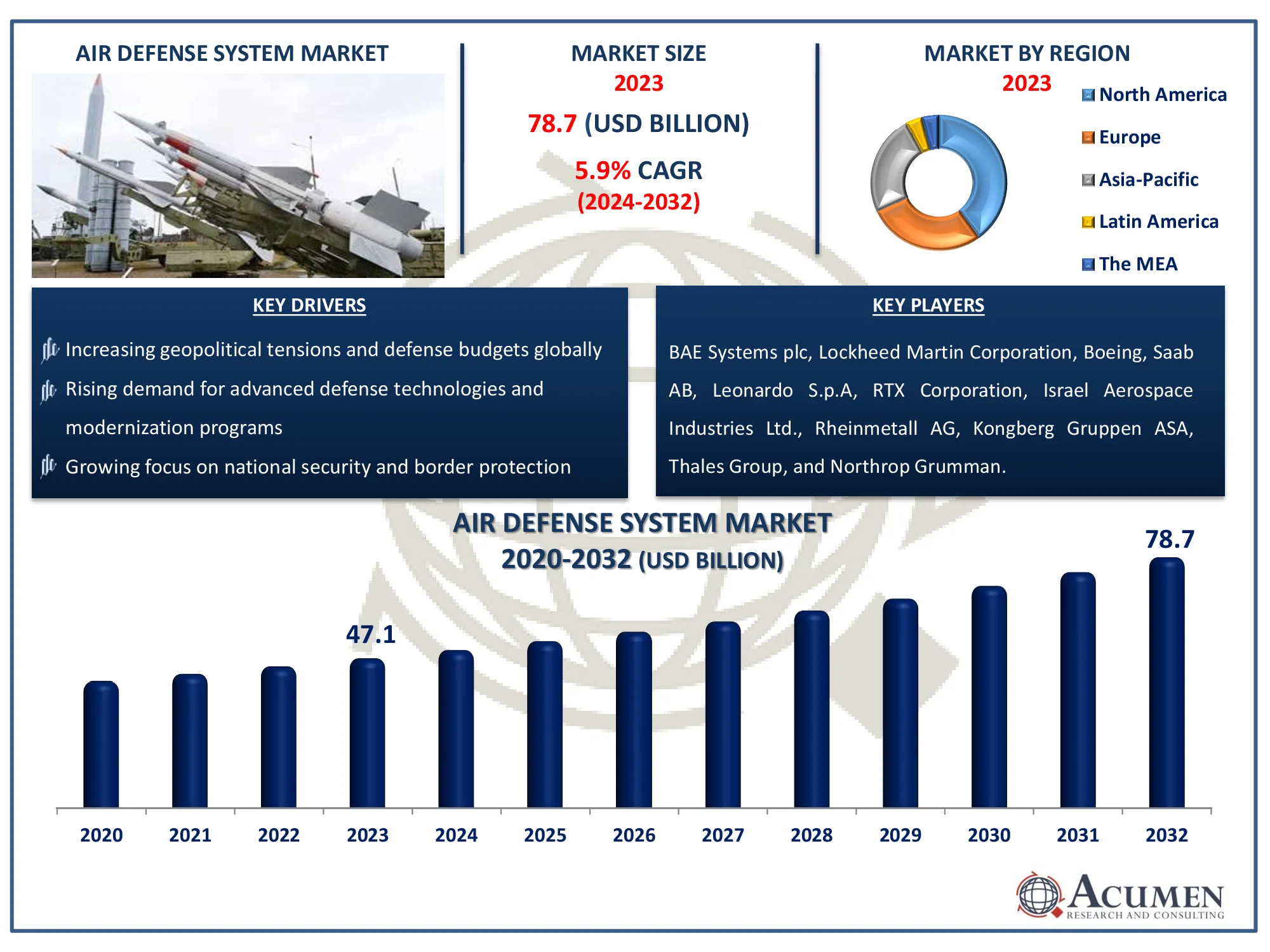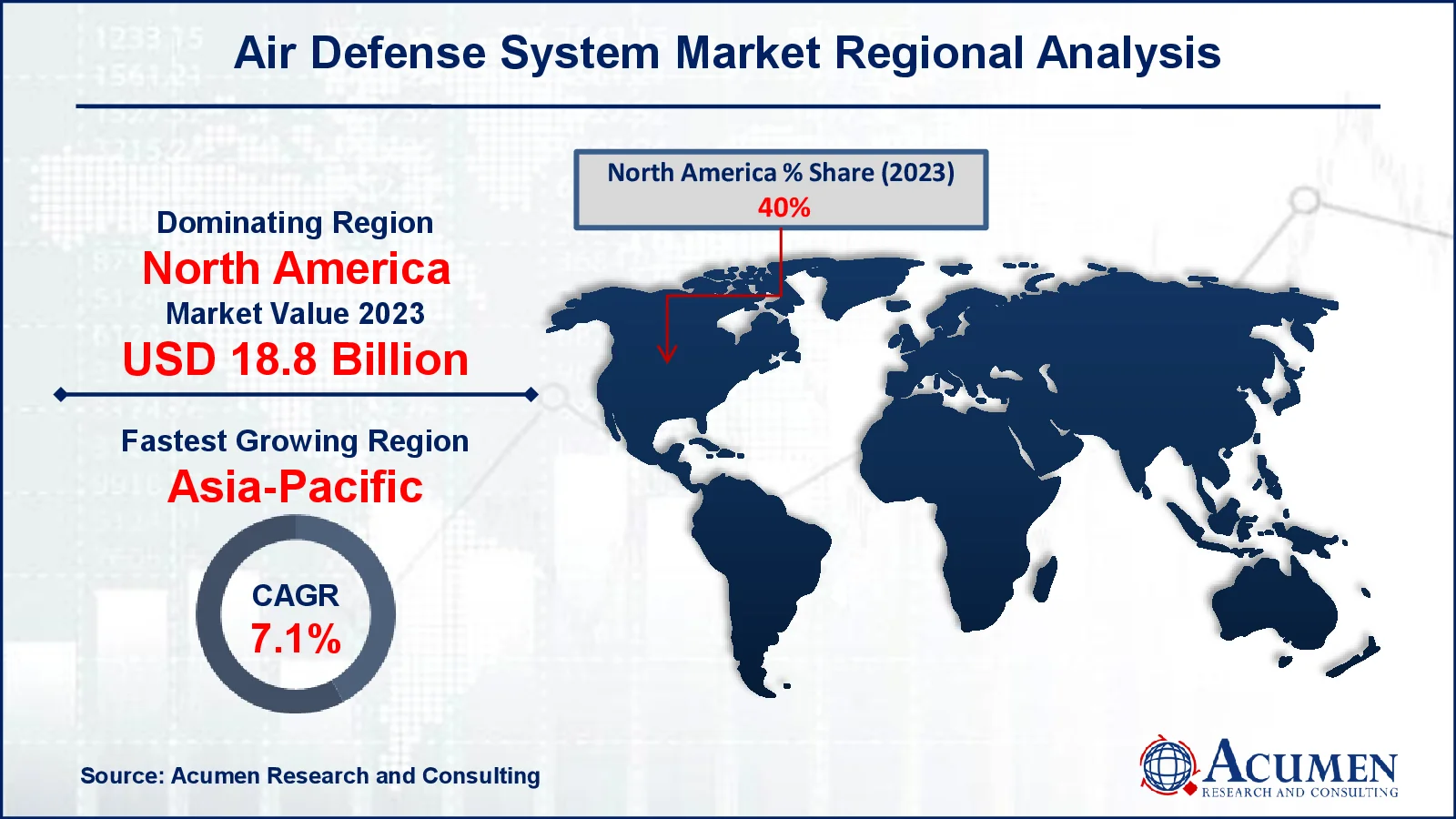March 2021
The global Air Defense System Market, projected to grow from USD 47.1 Billion in 2023 to USD 78.7 Billion by 2032, with a CAGR of 5.9% from 2024 to 2032. Stay updated on market trends and forecasts.
The Global Air Defense System Market Size accounted for USD 47.1 Billion in 2023 and is estimated to achieve a market size of USD 78.7 Billion by 2032 growing at a CAGR of 5.9% from 2024 to 2032.
Air Defense System Market Highlights

An air defense system is a structure that is developed to eliminate or decrease the effectiveness of threatening air action. It's used to enhance the effectiveness and readiness of air defense and other military forces, whether operating alone or in a joint warfare context, by conducting research, development, engineering, testing, and analysis of current and future air defense and related technologies and services. The primary goal of the air defense system is to keep enemy air attacks from interfering with maneuver force operations. Field units and other strategic threats are protected from attacks by cruise missiles, fixed-wing ground-attack jetliners, and armed helicopters by air defense forces.
Global Air Defense System Market Dynamics
Market Drivers
Market Restraints
Market Opportunities
Air Defense System Market Report Coverage
| Market | Air Defense System Market |
| Air Defense System Market Size 2022 |
USD 47.1 Billion |
| Air Defense System Market Forecast 2032 | USD 78.7 Billion |
| Air Defense System Market CAGR During 2023 - 2032 | 5.9% |
| Air Defense System Market Analysis Period | 2020 - 2032 |
| Air Defense System Market Base Year |
2023 |
| Air Defense System Market Forecast Data | 2024 - 2032 |
| Segments Covered | By Component, By System, By Platform, By Range, And By Geography |
| Regional Scope | North America, Europe, Asia Pacific, Latin America, and Middle East & Africa |
| Key Companies Profiled | BAE Systems plc, Lockheed Martin Corporation, Boeing, Saab AB, Leonardo S.p.A, RTX Corporation, Israel Aerospace Industries Ltd., Rheinmetall AG, Kongberg Gruppen ASA, Thales Group, and Northrop Grumman. |
| Report Coverage |
Market Trends, Drivers, Restraints, Competitive Analysis, Player Profiling, Covid-19 Analysis, Regulation Analysis |
Air Defense System Market Insights
The impending need for rapid modernization of defense forces with innovative air defense systems and strengthening national defense capability against increasing aerial threats such as drone swarms, ballistic missiles, military aircraft, and the latest hypersonic missiles is driving the growth. Increasing military expenditure for the improved performance and improvement of air and missile defense systems, as well as rising global instabilities around the world, are driving the market growth. Additionally, the vastly different nature of defense military operations has fueled the market growth.
Furthermore, the growing advancement of air and anti-missile defense systems in emerging economies, as well as technological advancements, are expected to have an equal impact on the industry overall growth over the air defense system market forecast period. Apart from this, high investment costs in the development of air defense systems may stifle market growth. Besides that, the Air defense system is based on a comprehensive and integrated use of airborne and/or field-based active and passive sensor systems, command and control centers, and various types of weapons. The air defense system serves as also used for a variety of operations such as air space surveillance using radars and electro-optic sensors.
Air Defense System Market Segmentation
The worldwide market for air defense system is split based on component, system, platform, range, and geography.
Air Defense Systems Market By Component
The weapon systems industry is expected to dominate the market due to its vital role in intercepting and repelling air threats. Surface-to-air missiles, anti-aircraft artillery, and laser-based weaponry form the basis of every air defense system. Rising geopolitical tensions and the frequency of aerial invasions have increased demand for more powerful weapon systems capable of combatting both classic and modern threats, such as drones and hypersonic missiles. Furthermore, governments around the world are making significant investments in updating their defense capabilities, which is bolstering this business even further. Weapon systems are expected to maintain their top position as technology progresses, with better precision, longer ranges, and integration with real-time tracking systems.
Air Defense Systems Market By System
According to air defense system industry analysis, based on the components, the market is categorized into three types: missile defense systems, anti-aircraft systems, and C-RAM systems. The missile defense system segment accounted for the largest market during the forecast. Missile defense systems are a type of missile defense system that is designed to protect a country from incoming missiles such as intercontinental ballistic missiles and other ballistic missiles. Furthermore, missile defense refers to a weapon, system, or technology that detects, tracks, intercepts, and destroys attacking missiles. Besides that, the Counter Rocket, Artillery, and Mortar systems (C-RAM) are expected to be in high demand in the coming years, owing to their effectiveness in intercepting missiles while also raising timely alarms to protect operating bases.
Air Defense Systems Market By Platform
The market for air defense systems has been divided into three platforms: naval, land, and airborne. The land segment is expected to lead the market in 2023, accounting for more than half of the air defense system market. Technological advancements in short-range, moderate and guided missile systems are supporting the demand of the land segment of the market. However, air force bases, critical military infrastructure, strategic assets, and other ground-based platforms depend on layered air defense systems for all-around security against advanced symmetric and asymmetric attacks, including small, moderate aerial targets.
Furthermore, military spending on the cutting-edge ground or field-based defense weapons, as well as the incorporation of machine intelligence in various weapon systems is expected to promote the evolution of next-generation ground defense systems during the projected timeframe.
Air Defense Systems Market By Range
Based on the range, the long-range defense system segment is projected to notable the air defense system market in 2023. Some of the major factors driving the growth of the global long-range air defense systems segment include an increase in military expenditure for the development of air defense systems, an increase in procurements of long-range air defense systems, changing nature of warfare, and an increase in geopolitical instabilities around the globe. Long-range missile strikes, intercontinental ballistic missiles, and asymmetric warfare are some of the factors driving the growth of the long-range defense (LRAD) system segment of the market. Furthermore, rising industrial growth and geopolitical tensions between China, India, and Pakistan are boosting the growth of LRAD systems.
Air Defense System Market Regional Outlook
North America
Europe
Asia-Pacific
Latin America
The Middle East & Africa

Air Defense System Market Regional Analysis
In terms of air defense system market analysis, North America is expected to hold a sizable industry share in 2023. The increase in military spending in the United States can be attributed to the market expansion of the North American air defense system. The addition of a new, advanced, and innovative defense system added to the existing, overage system will also have a massive influence on the market throughout the air defense systems market forecast period.
Moreover, the rise of political insurgencies in the United States, China, and Russia will also benefit air defense system market growth. The United States is keeping a close watch on these nations' armed forces and is upgrading its defense systems accordingly. For example, the United States allocated a defense spending of USD 816.7 billion in 2023, more than in previous years. As a result, the United States is the world's largest defense spender.
Air Defense System Market Players
Some of the top air defense system companies offered in our report include BAE Systems plc, Lockheed Martin Corporation, Boeing, Saab AB, Leonardo S.p.A, RTX Corporation, Israel Aerospace Industries Ltd., Rheinmetall AG, Kongberg Gruppen ASA, Thales Group, and Northrop Grumman.
Looking for discounts, bulk pricing, or custom solutions? Contact us today at sales@acumenresearchandconsulting.com
March 2021
March 2023
August 2023
August 2020